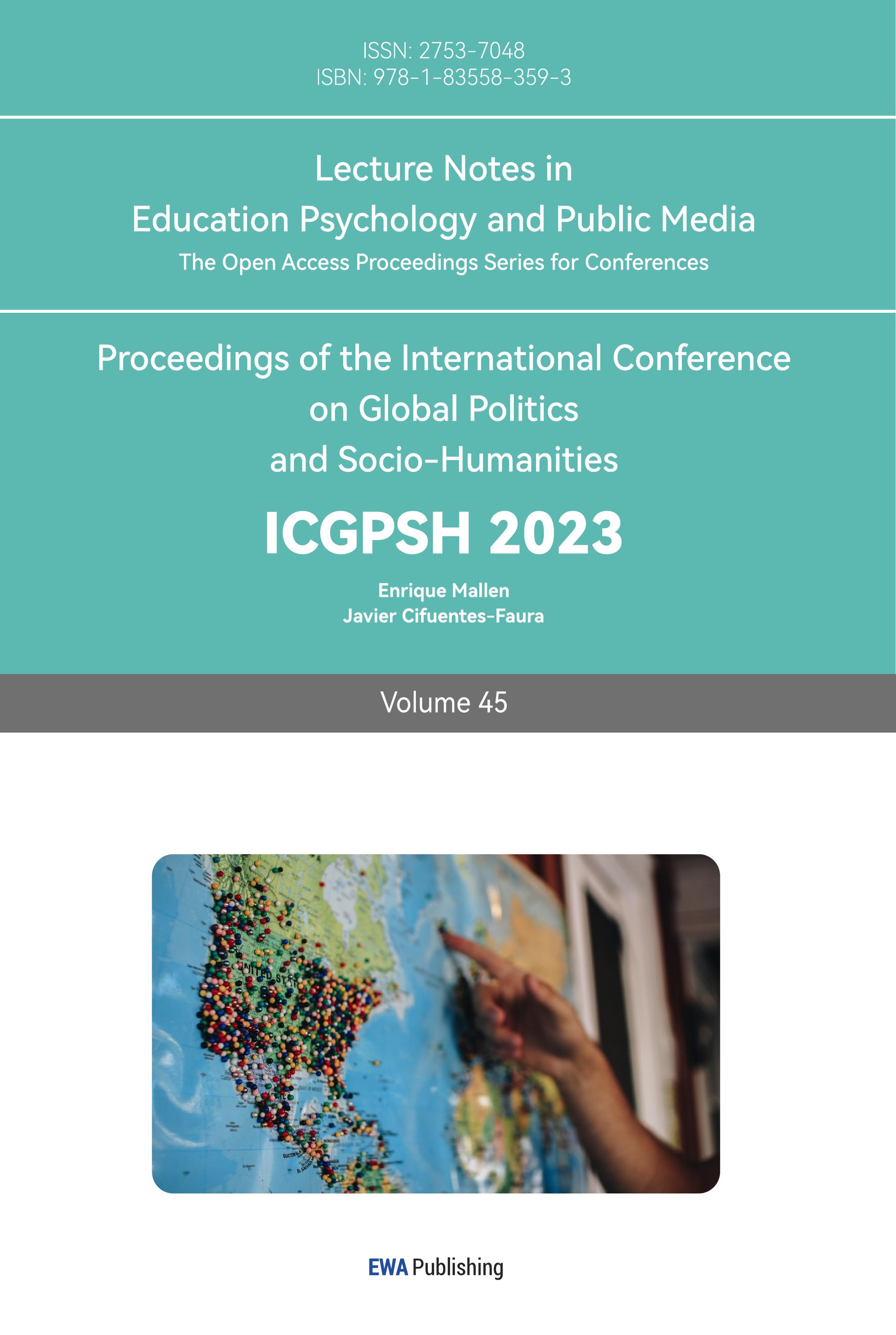References
[1]. R. C. Scarcella, & R. L. Oxford. (1992). The tapestry of language learning: The individual in the communicative classroom.
[2]. E. K. Horwitz, M. B. Horwit, & J. Cope. (1986). Foreign Language Classroom Anxiety. The Modern LanguageJournal, 70, 125-132.
[3]. J. H. Kim. (2000). Foreign language listening anxiety: A study of Korean students learning English. The University of Texas at Austin.
[4]. X. Zhang, & G. Y. Zhao. (2011). Construction Analysis and Validity Test of Foreign Language Listening Anxiety Scale. Modern Foreign Languages, 34(2), 162-170.
[5]. D. D. Zhou. (2003). Listening Anxiety and Affective Strategies in Second Language Classrooms. Foreign Language Teaching Theory and Practice, (3), 22-29, 21.
[6]. D. J. Young. (1991). Creating a low-anxiety classroom environment: What does language anxiety research suggest? The modern language journal, 75(4), 426-439.
[7]. A. J. Vogely, (1998). Listening comprehension anxiety: Students' reported sources and solutions. Foreign language annals, 31(1), 67-80
[8]. R. L. Oxford. (1999). Anxiety and the language learner: new insights. Affect in language learning, 58(3), 67-91.
[9]. H. Elkhafaifi. (2005). Listening comprehension and anxiety in the Arabic language classroom. The modern language journal, 89(2), 206-220.
[10]. A. C. S. CHANG, & J. Read. (2006). The effects of listening support on the listening performance of EFL learners. TESOL quarterly, 40(2), 375-397.
[11]. H. L. Hu. (2015). Causes and Countermeasures of English Classroom Speaking Anxiety Among English Major University Students. Curriculum Education Research, (36), 110.
[12]. G. G. H. Xiang, H. Wan, & L. Yan. (2020). Factors Affecting College Students’ English-Speaking Anxiety. Journal of Wuhan Institute of Engineering, 32(3), 55-58.
[13]. X. Luo. (2017). A Survey on the Oral Anxiety of Non-English Major Freshmen: A Case Study of a Second-tier College in Jiangxi Province. Journal of Guangxi Science and Technology Normal University, 32(4), 18-21.
[14]. F. Fang. (2013). An Empirical Study on the Relationship between English Classroom Anxiety and Oral Performance. Journal of Lanzhou Institute of Education, 29(10), 121-123.
Cite this article
He,S.;Wang,S. (2024). Exploring Foreign Language Anxiety in the Listening and Speaking of Learning English as a Second Language. Lecture Notes in Education Psychology and Public Media,45,209-215.
Data availability
The datasets used and/or analyzed during the current study will be available from the authors upon reasonable request.
Disclaimer/Publisher's Note
The statements, opinions and data contained in all publications are solely those of the individual author(s) and contributor(s) and not of EWA Publishing and/or the editor(s). EWA Publishing and/or the editor(s) disclaim responsibility for any injury to people or property resulting from any ideas, methods, instructions or products referred to in the content.
About volume
Volume title: Proceedings of the International Conference on Global Politics and Socio-Humanities
© 2024 by the author(s). Licensee EWA Publishing, Oxford, UK. This article is an open access article distributed under the terms and
conditions of the Creative Commons Attribution (CC BY) license. Authors who
publish this series agree to the following terms:
1. Authors retain copyright and grant the series right of first publication with the work simultaneously licensed under a Creative Commons
Attribution License that allows others to share the work with an acknowledgment of the work's authorship and initial publication in this
series.
2. Authors are able to enter into separate, additional contractual arrangements for the non-exclusive distribution of the series's published
version of the work (e.g., post it to an institutional repository or publish it in a book), with an acknowledgment of its initial
publication in this series.
3. Authors are permitted and encouraged to post their work online (e.g., in institutional repositories or on their website) prior to and
during the submission process, as it can lead to productive exchanges, as well as earlier and greater citation of published work (See
Open access policy for details).
References
[1]. R. C. Scarcella, & R. L. Oxford. (1992). The tapestry of language learning: The individual in the communicative classroom.
[2]. E. K. Horwitz, M. B. Horwit, & J. Cope. (1986). Foreign Language Classroom Anxiety. The Modern LanguageJournal, 70, 125-132.
[3]. J. H. Kim. (2000). Foreign language listening anxiety: A study of Korean students learning English. The University of Texas at Austin.
[4]. X. Zhang, & G. Y. Zhao. (2011). Construction Analysis and Validity Test of Foreign Language Listening Anxiety Scale. Modern Foreign Languages, 34(2), 162-170.
[5]. D. D. Zhou. (2003). Listening Anxiety and Affective Strategies in Second Language Classrooms. Foreign Language Teaching Theory and Practice, (3), 22-29, 21.
[6]. D. J. Young. (1991). Creating a low-anxiety classroom environment: What does language anxiety research suggest? The modern language journal, 75(4), 426-439.
[7]. A. J. Vogely, (1998). Listening comprehension anxiety: Students' reported sources and solutions. Foreign language annals, 31(1), 67-80
[8]. R. L. Oxford. (1999). Anxiety and the language learner: new insights. Affect in language learning, 58(3), 67-91.
[9]. H. Elkhafaifi. (2005). Listening comprehension and anxiety in the Arabic language classroom. The modern language journal, 89(2), 206-220.
[10]. A. C. S. CHANG, & J. Read. (2006). The effects of listening support on the listening performance of EFL learners. TESOL quarterly, 40(2), 375-397.
[11]. H. L. Hu. (2015). Causes and Countermeasures of English Classroom Speaking Anxiety Among English Major University Students. Curriculum Education Research, (36), 110.
[12]. G. G. H. Xiang, H. Wan, & L. Yan. (2020). Factors Affecting College Students’ English-Speaking Anxiety. Journal of Wuhan Institute of Engineering, 32(3), 55-58.
[13]. X. Luo. (2017). A Survey on the Oral Anxiety of Non-English Major Freshmen: A Case Study of a Second-tier College in Jiangxi Province. Journal of Guangxi Science and Technology Normal University, 32(4), 18-21.
[14]. F. Fang. (2013). An Empirical Study on the Relationship between English Classroom Anxiety and Oral Performance. Journal of Lanzhou Institute of Education, 29(10), 121-123.









